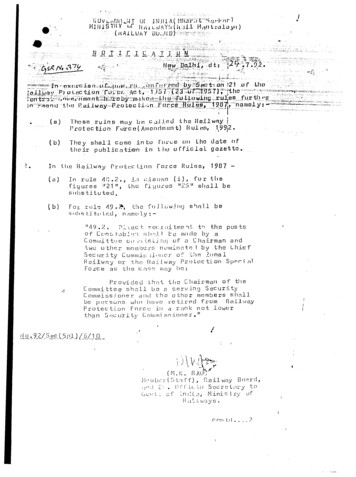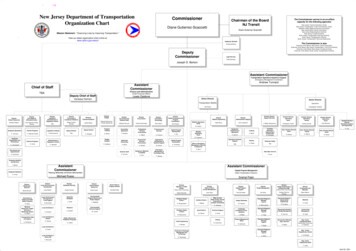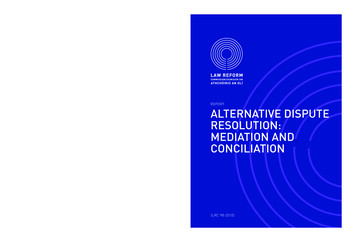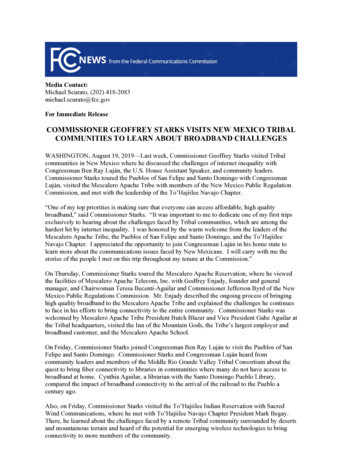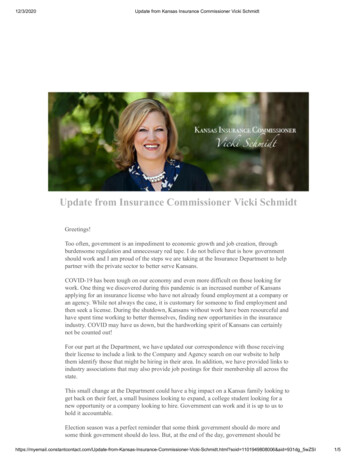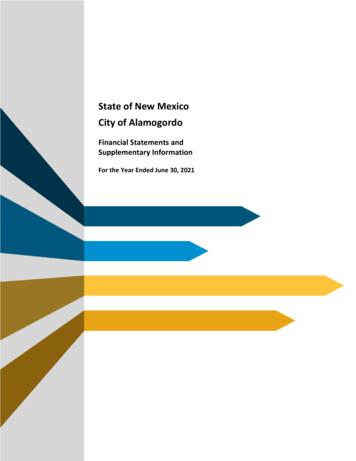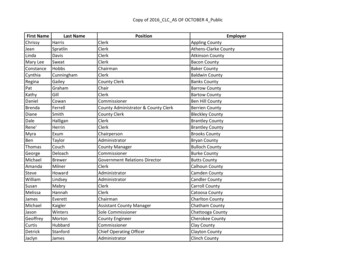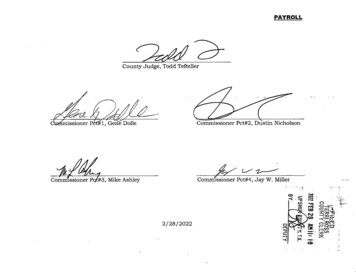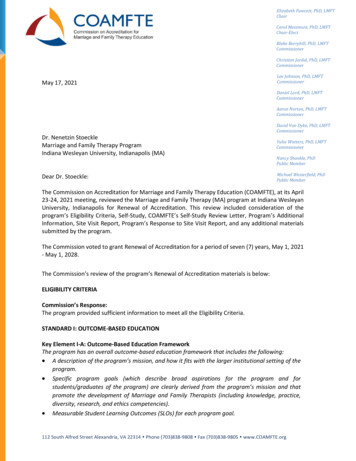
Transcription
Elizabeth Fawcett, PhD, LMFTChairCarol Messmore, PhD, LMFTChair-ElectBlake Berryhill, PhD, LMFTCommissionerChristian Jordal, PhD, LMFTCommissionerMay 17, 2021Lee Johnson, PhD, LMFTCommissionerDaniel Lord, PhD, LMFTCommissionerAaron Norton, PhD, LMFTCommissionerDavid Van Dyke, PhD, LMFTCommissionerDr. Nenetzin StoeckleMarriage and Family Therapy ProgramIndiana Wesleyan University, Indianapolis (MA)Yulia Watters, PhD, LMFTCommissionerDear Dr. Stoeckle:Michael Westerfield, PhDPublic MemberNancy Shankle, PhDPublic MemberThe Commission on Accreditation for Marriage and Family Therapy Education (COAMFTE), at its April23-24, 2021 meeting, reviewed the Marriage and Family Therapy (MA) program at Indiana WesleyanUniversity, Indianapolis for Renewal of Accreditation. This review included consideration of theprogram’s Eligibility Criteria, Self-Study, COAMFTE’s Self-Study Review Letter, Program’s AdditionalInformation, Site Visit Report, Program’s Response to Site Visit Report, and any additional materialssubmitted by the program.The Commission voted to grant Renewal of Accreditation for a period of seven (7) years, May 1, 2021- May 1, 2028.The Commission’s review of the program’s Renewal of Accreditation materials is below:ELIGIBILITY CRITERIACommission’s Response:The program provided sufficient information to meet all the Eligibility Criteria.STANDARD I: OUTCOME-BASED EDUCATIONKey Element I-A: Outcome-Based Education FrameworkThe program has an overall outcome-based education framework that includes the following: A description of the program’s mission, and how it fits with the larger institutional setting of theprogram. Specific program goals (which describe broad aspirations for the program and forstudents/graduates of the program) are clearly derived from the program’s mission and thatpromote the development of Marriage and Family Therapists (including knowledge, practice,diversity, research, and ethics competencies). Measurable Student Learning Outcomes (SLOs) for each program goal.112 South Alfred Street Alexandria, VA 22314 Phone (703)838-9808 Fax (703)838-9805 www.COAMFTE.org
Indiana Wesleyan University, Indianapolis (MA)Dr. Nenetzin StoeckleMay 17, 2021Page 2 of 12 Programs must include SLOs that measure student/graduate achievement appropriate to theprogram’s mission and goals.Specific assessment measures for operationalizing the achievement of Student LearningOutcomes (including student/graduate achievement) including targets and benchmarks.Measurement includes assessment of students’ academic and professional competencies by thefaculty and others, appropriate to the program’s mission, goals, and outcomes.Commission’s Response:The program meets the requirements of this Key Element.Key Element I-B: Assessment Plan with Mechanisms and TimelineThe program has an overall assessment plan that includes: Mechanisms in place for evaluating/reviewing the Student Learning Outcomes, includingstudent/graduate achievements (utilizing specific measures identified in I-A). Mechanisms in place for evaluating student support services; curriculum and teaching/learningpractices; fiscal and physical resources; technological resources; and instructional and clinicalresources to determine sufficiency for attainment of targeted program outcomes. An assessment plan and corresponding timeline that addresses when, from whom, and how datais collected, and a description of how data will be aggregated and analyzed and the findings usedfor program improvement (feedback loop). The assessment plan should include a specificdescription of how the program will review and revise, as needed, their overall outcome-basededucation framework and assessment plan. The assessment plan must incorporate feedback from Communities of Interest (as defined in KeyElement I-C).Commission’s Response:The program meets the requirements of this Key Element.Key Element I-C: Communities of InterestThe program identifies its Communities of Interest, obtains formal and informal feedback from them,and describes how they inform the program’s mission, goals, and Student Learning Outcomes.Communities of Interest vary according to the program’s mission, goals, and outcomes and mayinclude, but are not limited to, students, administrators, faculty, supervisors, consumers, graduates,potential employers, germane regulatory bodies, germane private and public funding sources, anddiverse, marginalized, and/or underserved groups within these communities.Commission’s Response:The program meets the requirements of this Key Element.
Indiana Wesleyan University, Indianapolis (MA)Dr. Nenetzin StoeckleMay 17, 2021Page 3 of 12STANDARD II: COMMITMENT TO DIVERSITY AND INCLUSIONKey Element II-A: Multiculturally-informed Education ApproachThe program has a multiculturally-informed educational approach that includes:1) specific program goals with specific Student Learning Outcomes reflecting a commitment todiversity and inclusion;2) an overarching definition of diversity; and3) curriculum elements with accompanying teaching/learning practices consistent with theprogram’s mission. The educational approach includes the teaching of ideas and professionalpractices for MFTs that address a range of diversity, including (but not limited to) race, age,gender, ethnicity, sexual orientation, gender identity, socioeconomic status, disability, healthstatus, religious, spiritual, and/or political beliefs, nation of origin or other relevant socialcategories, immigration or language.Commission’s Response:The program meets the requirements of this Key Element.Key Element II-B: Program Climate of Safety, Respect, and Appreciation The program has demonstrated systematic efforts and has an ongoing comprehensive strategyin place to attract and retain a diverse student body, faculty, and supervisors. The program demonstrates a climate of safety, respect, and appreciation for all learnersincluding those from diverse, marginalized, and/or underserved communities, and hasmechanisms in place for evaluating the climate and responding to any feedback regarding theclimate.Commission’s Response:The program meets the requirements of this Key Element. The program provided evidence of asystematic and ongoing effort to attract and retain a diverse faculty and supervisors.Key Element II-C: Experience with Diverse, Marginalized, and/or Underserved CommunitiesThe program demonstrates student experience in Couple or Marriage and Family Therapy practicewith diverse, marginalized, and/or underserved communities. Experiences may include:1) professional activities (such as therapy, research, supervision, consultation, teaching, etc.) withdiverse, marginalized, and/or underserved communities; and/or2) other types of activities (such as projects, service, interviews, workshops, etc.), as long as theprogram can demonstrate that the experience is directly related to MFT activities, and studentsare in interaction with members of these communities.Commission’s Response:The program meets the requirements of this Key Element.
Indiana Wesleyan University, Indianapolis (MA)Dr. Nenetzin StoeckleMay 17, 2021Page 4 of 12STANDARD III: INFRASTRUCTURE AND ENVIRONMENTAL SUPPORTSKey Element III-A: Fiscal and Physical ResourcesThe program demonstrates that fiscal and physical resources are sufficient to achieve the program’smission, goals, and outcomes. These resources are reviewed, revised as needed, and support programeffectiveness.Commission’s Response:The program meets the requirements of this Key Element.Key Element III–B: Technological ResourcesThe program demonstrates that technological resources (e.g., laptops, audio/visual equipment, EMRsand Billing Systems, Virtual Meeting Space) are secure, confidential, Health Insurance Portability andAccountability Act compliant (if relevant), and sufficient to achieve the program’s mission, goals, andoutcomes. These resources are reviewed, revised as needed, and support program effectiveness.Commission’s Response:The program meets the requirements of this Key Element. The program provided evidence of aprocess for the review and revision of technological resources.Key Element III-C: Instructional and Clinical ResourcesThe program demonstrates that instructional and clinical resources (e.g., space, personnel, supplies)are sufficient to enable the program to meet the program’s mission, goals, and outcomes. Theseresources are reviewed, revised as needed, and support program effectiveness.Commission’s Response:The program meets the requirements of this Key Element.Key Element III-D: Academic Resources and Student Support ServicesThe program demonstrates that academic resources (e.g., library, advising, writing centers) andstudent support services (e.g., access to counseling, financial advising) are accessible to students andsufficient to achieve the program’s mission, goals, and outcomes. These resources are reviewed basedon core faculty and student input, and the program takes action or advocates for institutional changeto address areas required for program effectiveness.Commission’s Response:The program meets the requirements of this Key Element.Key Element III-E: Faculty Qualifications & ResponsibilitiesThe faculty roles, in teaching, scholarship, service, and practice are identified clearly and are congruentwith the program’s mission, goals, and outcomes. The faculty members are academically, professionally, and experientially qualified to achieve theprogram’s mission, goals, and outcomes. The qualifications must be identified in documenteddescriptions of roles and responsibilities. Faculty members must have documented expertise in
Indiana Wesleyan University, Indianapolis (MA)Dr. Nenetzin StoeckleMay 17, 2021Page 5 of 12 their area(s) of teaching responsibility and knowledge of the content delivery method (e.g.,distance learning).The program must demonstrate that it has mechanisms for reviewing and evaluating facultyeffectiveness in support of the program’s mission, goals, and outcomes. Faculty evaluationsinclude explicit links to the program’s mission, goals, and outcomes.Commission’s Response:The program meets the requirements of this Key Element.Key Element III-F: Faculty SufficiencyThe faculty must be sufficient in number with a faculty-student ratio that permits the achievement ofthe program’s mission, goals, and outcomes and ensures that student educational needs are met.These resources are reviewed, revised as needed, and support program effectiveness. The program must have sufficient core faculty members who are knowledgeable and involved inongoing program development, delivery, and evaluation required to achieve the program’smission, goals, and outcomes. The program must have a stated process for evaluation of ongoing sufficiency of facultyresources. The program must demonstrate there are sufficient faculty and effective linking mechanisms withfeedback loops, such as regular coordination, meetings, and/or communication, to connect andinvolve all faculty members in the achievement of expected and actual Student LearningOutcomes of the program. The program is permitted to use a combination of full-time, part-time and/or multiple adjuncts.Commission’s Response:The program meets the requirements of this Key Element. The program provided evidence of howinput from the Communities of Interest is used to determine sufficiency of faculty.Key Element III-G: Governance of ProgramRoles of faculty and student participation in the governance of the program are clearly defined andenable the program to meet the program’s mission, goals, and outcomes.The program must describe decision-making processes and procedures at the program andinstitutional levels regarding the operation of the program that support program effectiveness.Commission’s Response:The program meets the requirements of this Key Element.Key Element III-H: Supervisor Qualifications & ResponsibilitiesSupervisors must be AAMFT Approved Supervisors or meet the supervisor equivalency definition in theglossary. Supervisor roles, as distinguished from teaching faculty, are identified clearly and arecongruent with the program’s mission, goals, and outcomes.
Indiana Wesleyan University, Indianapolis (MA)Dr. Nenetzin StoeckleMay 17, 2021Page 6 of 12 Supervisors are academically, professionally, and experientially qualified to achieve theprogram’s mission, goals, and outcomes. The qualifications must be identified in documenteddescriptions of roles and responsibilities.If supervisor equivalency is used, there must be full disclosure to students in order for them tomake informed decisions and evaluate regulatory implications for otherstates/provinces/locations.Commission’s Response:The program meets the requirements of this Key Element.Key Element III-I: Supervisor SufficiencySupervisors must be sufficient in number with a supervisor-student ratio that permits the achievementof the program’s mission, goals, and outcomes, especially Student Learning Outcomes. Supervisoryresources are reviewed, revised as needed, and support program effectiveness. The program must have a stated process for evaluation of ongoing sufficiency of supervisorresources. The program must demonstrate there are sufficient and effective linking mechanisms withfeedback loops, such as regular coordination, meetings, and/or communication, connecting andinvolving all supervisors in the achievement of expected and actual achievement of StudentLearning Outcomes within the program.Commission’s Response:The program meets the requirements of this Key Element.STANDARD IV: CURRICULUMKey Element IV-A: Curriculum and Teaching/Learning PracticesThe program must provide: A description of the logical sequencing of the curriculum and practice components, includingrationale for how the program’s goals and accompanying Student Learning Outcomes fit withinthe program offered (e.g., where goals and outcomes are addressed and assessed within thecurriculum). A description of key teaching/learning practices used to accomplish program goals, and StudentLearning Outcomes. A description of processes and procedures to ensure and monitor student progress andcompletion of requirements. A description of governance processes and procedures for designing, approving, implementing,reviewing, and changing the curriculum.Commission’s Response:The program meets the requirements of this Key Element.
Indiana Wesleyan University, Indianapolis (MA)Dr. Nenetzin StoeckleMay 17, 2021Page 7 of 12Key Element IV-B: Foundational and Advanced CurriculaFoundational CurriculumThe foundational curriculum covers the knowledge and skill required to practice as a MFT by coveringthe Foundational Curricular Areas below. Master’s degree program must demonstrate that they offer course work that covers all the FCAsthat make up the foundational curriculum. Doctoral degree programs must demonstrate that they offer course work and/or that studentshave completed course work, in all the areas contained in the foundational curriculum or thatstudents demonstrate competence in those areas. Post-degree programs must demonstrate that they offer course work and/or that students havecompleted course work in all the areas contained in the foundational curriculum, or that studentsdemonstrate competence in those areas. Programs may combine more than one of these foundational curriculum areas into a singlecourse, as they build their curriculum in ways that are congruent with the program’s mission,goals, and outcomes. Programs may emphasize some of the areas more than others and include other areas that areconsistent with their program’s mission, goals and outcomes. Programs may include anotherlayer of requirements based on a specialization or emphasis (e.g., faith-based orientation,licensure laws, specialized certification, and so on) as long as there is a clear rationale andrelational/systemic philosophy in the majority of the program. Minimum semester/quarter credits or equivalent clock hours are established for the first sevencurricular areas. Programs may choose what combination of additional area 1 through 7semester/quarter credits or equivalent clock hours beyond the individual area minimums will betaught consistent with their program’s mission, goals, and outcomes. Programs must require students to develop and/or present an integrative/capstone experiencebefore completion of their degree program as part of the foundational curriculum below.Programs must decide how to meet this requirement in keeping with the program’s mission,goals, and outcomes. Examples include: a theory of change/therapy theory presentation/paper,a thesis, a therapy portfolio, or a capstone course.FCA 1: Foundations of Relational/Systemic Practice, Theories & Models (Minimum of 6 semestercredits/8 quarter credits/90 clock hours)This area facilitates students developing competencies in the foundations and critical epistemologicalissues of MFTs. It includes the historical development of the relational/systemic perspective andcontemporary conceptual foundations of MFTs, and early and contemporary models of MFT, includingevidence-based practice and the biopsychosocial perspective.FCA 2: Clinical Treatment with Individuals, Couples and Families (Minimum of 6 Credits/8 quartercredits/90 clock hours)This area facilitates students developing competencies in treatment approaches specifically designedfor use with a wide range of diverse individuals, couples, and families, including sex therapy, same-sex
Indiana Wesleyan University, Indianapolis (MA)Dr. Nenetzin StoeckleMay 17, 2021Page 8 of 12couples, working with young children, adolescents and elderly, interfaith couples, and includes a focuson evidence-based practice. Programs must include content on crisis intervention.FCA 3: Diverse, Multicultural and/or Underserved Communities (Minimum of 3 Credits/4 quartercredits/45 clock hours)This area facilitates students developing competencies in understanding and applying knowledge ofdiversity, power, privilege and oppression as these relate to race, age, gender, ethnicity, sexualorientation, gender identity, socioeconomic status, disability, health status, religious, spiritual and/orbeliefs, nation of origin or other relevant social categories throughout the curriculum. It includespractice with diverse, international, multicultural, marginalized, and/or underserved communities,including developing competencies in working with sexual and gender minorities and their families aswell as anti-racist practices.FCA 4: Research & Evaluation (Minimum of 3 Credits/4 quarter credits/45 clock hours)This area facilitates students developing competencies in MFT research and evaluation methods, andin evidence-based practice, including becoming an informed consumer of couple, marriage, and familytherapy research. If the program’s mission, goals, and outcomes include preparing students fordoctoral degree programs, the program must include an increased emphasis on research.FCA 5: Professional Identity, Law, Ethics & Social Responsibility (Minimum of 3 Credits/4 quartercredits/45 clock hours)This area addresses the development of a MFT Identity and socialization, and facilitates studentsdeveloping competencies in ethics in MFT practice, including understanding and applying the AAMFTCode of Ethics and understanding legal responsibilities.FCA 6: Biopsychosocial Health & Development Across the Life Span (Minimum of 3 Credits/4 quartercredits/45 clock hours)This area addresses individual and family development, human sexuality, and biopsychosocial healthacross the lifespan.FCA 7: Systemic/Relational Assessment & Mental Health Diagnosis and Treatment (Minimum of 3Credits/4 quarter credits/45 clock hours)This area facilitates students developing competencies in traditional psycho-diagnostic categories,psychopharmacology, the assessment, diagnosis, and treatment of major mental health issues as wellas a wide variety of common presenting problems including addiction, suicide, trauma, abuse, intrafamilial violence, and therapy for individuals, couples, and families managing acute chronic medicalconditions, utilizing a relational/systemic philosophy.The following areas must be covered in the curriculum in some way, though there are no minimumcredit requirements.FCA 8: Contemporary IssuesThis area facilitates students developing competencies in emerging and evolving contemporarychallenges, problems, and/or recent developments at the interface of Couple or Marriage and FamilyTherapy knowledge and practice, and the broader local, regional, and global context. This includes
Indiana Wesleyan University, Indianapolis (MA)Dr. Nenetzin StoeckleMay 17, 2021Page 9 of 12such issues as immigration, technology, same-sex marriage, violence in schools, etc. These issues areto reflect the context of the program and the program’s mission, goals, and outcomes. Programs areencouraged to innovate in this Foundational Curricular Area.FCA 9: Community Intersections & CollaborationThis area facilitates students developing competencies in practice within defined contexts (e.g.,healthcare settings, schools, military settings, private practice) and/or nontraditional MFTprofessional practice using therapeutic competencies congruent with the program’s mission, goals,and outcomes (e.g., community advocacy, psycho-educational groups). It also addresses developingcompetency in multidisciplinary collaboration.Commission’s Response:The program meets the requirements of this Key Element.Key Element IV-C: Foundational and Advanced Application ComponentsThe program must demonstrate they offer an application component with appropriate placement inthe curriculum, duration, focus, and intensity consistent with their program’s mission, goals, andoutcomes.Foundational Practice Component Master’s degree program and Post-degree programs that teach the foundational curriculumoffer the foundational practice component (practicum and/or internship). Includes a minimum of 500 clinical contact hours with individuals, couples, families and othersystems physically present, at least 40% of which must be relational. The 500 hours must occurover a minimum of twelve months of clinical practice. The 500 hours may include a maximum of100 alternative hours or clinical activity (e.g., couple or family groups, live cases where reflectingteams are directly involved in working with clients, etc.) that is directly related to the program’smission, outcomes, and goals. Alternatively, the program may demonstrate that graduatingstudents achieve a competency level equivalent to the 500 client contact hours. The programmust define this competency level and document how students are evaluated and achieve thedefined level. The program demonstrates a consistent set of evaluation criteria for achieving thedefined level of competency across all students. In addition, programs that do not require 500hours must document that students are informed about licensure portability issues that mayresult from not having 500 hours. Those programs requiring less than 500 hours may not usealternative hours to count toward total client contact hours. The program demonstrates a commitment to relational/systemic-oriented supervision. Studentsmust receive at least 100 hours of supervision and must receive supervision from an AAMFTApproved Supervisor or Supervisor Candidate for at least one hour each week in which they areseeing clients. Additional supervision may be provided by AAMFT Approved Supervisors,Supervisor Equivalents, or State Approved Supervisors. Supervision can be individual (onesupervisor with one or two supervisees) or group (one supervisor and eight or fewer students)and must include a minimum of 50 hours of supervision utilizing observable data. Supervisionmay utilize digital technology in which participants are not in the same location as long as the
Indiana Wesleyan University, Indianapolis (MA)Dr. Nenetzin StoeckleMay 17, 2021Page 10 of 12 majority of supervision is with supervisor and supervisee physically present in the same locationand appropriate mechanisms/precautions are in place to ensure the confidentiality and securityof the means of technology delivery.Programs have agreements with practice sites that outline the institutions’, the practice sites’and the students’ responsibilities, and published procedures in place for managing any difficultieswith sites, supervisors, or students.Commission’s Response:The program meets the requirements of this Key Element.Key Element IV-D: Program and Regulatory AlignmentThe program demonstrates that graduates have met educational and clinical practice requirements(e.g., coursework, clinical experience, and supervision) that satisfy the regulatory requirements forentry-level practice in the state, province, or location in which the program physically resides or inwhich the student intends to practice. Programs must also document that students are informed (e.g.,demonstrate review of appropriate regulatory sites or licensing laws) about the educational, clinical,and regulatory requirements for entry-level practice in the state, province, or location in which eachstudent resides or intends to practice.Commission’s Response:The program meets the requirements of this Key Element.Key Element IV-E: Curriculum/Practice Alignment with Communities of InterestThe program demonstrates that it considers the needs and expectations of identified Communities ofInterest in developing and revising its curriculum and application component.Commission’s Response:The program meets the requirements of this Key Element.STANDARD V: PROGRAM EFFECTIVENESS AND IMPROVEMENTKey Element V-A: Demonstrated Student/Graduate AchievementThe program provides aggregated data regularly collected on student/graduate achievement.Commission’s Response:The program meets the requirements of this Key Element.Key Element V-B: Demonstrated Achievement of Program GoalsThe program describes how data was analyzed and provides aggregated data that demonstratesachievement of each program goal via data from measured Student Learning Outcomes, based ontargets and benchmarks provided in the program’s outcome-based education framework—data fromStudent Learning Outcomes demonstrate that the program is meeting program goals.
Indiana Wesleyan University, Indianapolis (MA)Dr. Nenetzin StoeckleMay 17, 2021Page 11 of 12Commission’s Response:The program meets the requirements of this Key Element. The program provided evidence of how theprogram analyzes aggregated data to demonstrate achievement of the Student Learning Outcomes.Key Element V-C: Demonstrated Achievement of Faculty EffectivenessThe program must demonstrate faculty effectiveness in achieving the program’s mission, goals, andoutcomes. The program provides aggregated data that demonstrates the Program Director provideseffective leadership for the program to achieve its program’s mission, goals, and outcomes. The program provides aggregated data that demonstrates the performance and achievementsof faculty that support attainment of the program’s mission, goals, and outcomes.Commission’s Response:The program meets the requirements of this Key Element.Key Element V-D: Demonstrated Program ImprovementThe program demonstrates how evidence is used to maintain the achievement of Student LearningOutcomes and/or foster program improvement with plans for future improvement based on theevidence. Evidence includes but is not limited to findings regarding program goals and outcomes,student/graduate achievement, Communities of Interest, and evaluations (as described in theassessment plan) of curriculum and teaching/learning practices; fiscal and physical resources;technological resources; instructional and clinical resources; academic resources; and student supportresources. Data should demonstrate that the program is meeting its goals and outcomes, especiallyspecified targets and benchmarks and if not, what plans the program has for meeting or modifying itsgoals.Commission’s Response:The program meets the requirements of this Key Element. The program provided evidence of how ituses Student Learning Outcomes achievement data to inform its plan for program improvement.The following documents must be submitted in the required format by the noted deadlines:DocumentSubmission DeadlineAnnual ReportJanuary 31, 2022In accordance with COAMFTE policy, the program will need to submit an Annual Report on January31st of every year of your accreditation term.
Indiana Wesleyan University, Indianapolis (MA)Dr. Nenetzin StoeckleMay 17, 2021Page 12 of 12Please feel free to contact the Accreditation Office by e-mail at coa@aamft.org or by phone at (703)253-0448 if you have further questions or if you would like any additional information.Sincerely,Elizabeth Fawcett, PhDCOAMFTE ChairJill FogolinDirector of Accreditation
Indiana Wesleyan University, Indianapolis (MA) Dear Dr. Stoeckle: The Commission on Accreditation for Marriage and Family Therapy Education (COAMFTE), at its April 23-24, 2021 meeting, reviewed the Marriage and Family Therapy (MA) program at Indiana Wesleyan University, Indianapolis for Renewal ofAccreditation.


